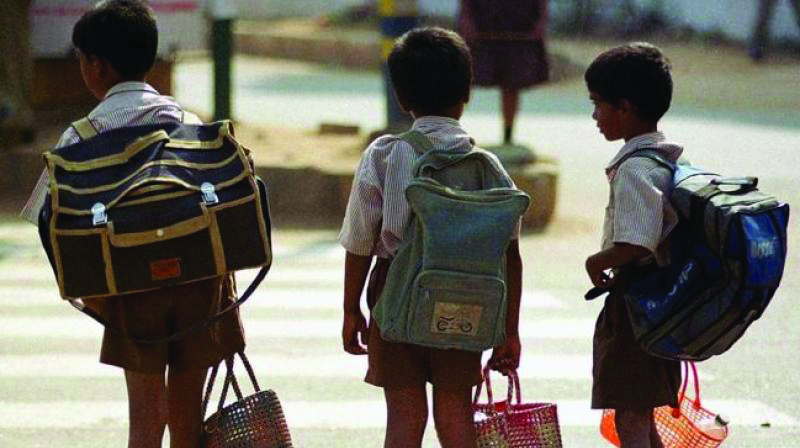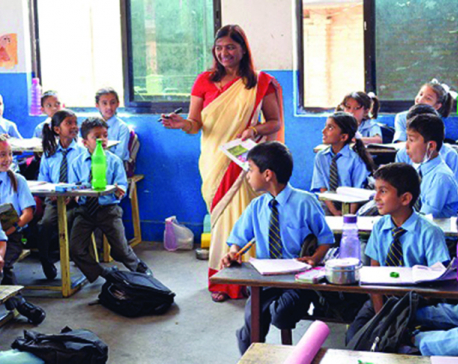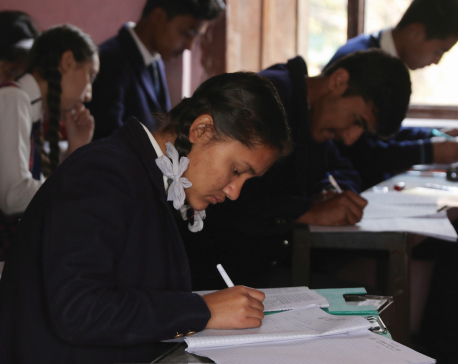
OR


Buddi Kumar Shrestha
The author is involved in research, community development and human rights sectornews@myrepublica.com
More from Author
Different studies have shown that heavy school bags have multiple negative effects on students, including physical, psychological and economic impacts
My son, a primary level student, frequently complains about heavy bags. I wanted to check for myself if he was right. So before he left school, I lifted his school bag and it was almost seven kilograms! I wondered how these kids will be able to carry this burden on their fragile backs. Why do schools prescribe so many books for kids?
The text books are only the tools to attain the educational achievement set in curriculum. Back in the past, because there were no alternatives, the students had to carry all books in their satchels. This continues even today. Our classrooms are fully guided by textbooks. Whatever is decided by the school is adopted as holy hymn and is accepted by the stakeholders as normal.
Education has been understood more as human institution than human activities. The primary focus is on uniform, school bags, books, buildings etc. Entire education system seems to be driven by the market and its interest. So they recommend more books for the school students.
Few weeks back, a picture of around 10 years old school boy holding his bag pack on a railing had gone viral in social media. This gives the idea of how much our children are struggling to hold their bags rather than enjoying their study. Institutional School Criteria and Operation Directives (2012) have something regarding the weight of school bags. It states that bag of students from the first to fifth grades must not weigh more than four kilos, for sixth to eighth grades it must not exceed six kilos, and for ninth and tenth grades the limit is eight kilos, including lunch boxes and other stuff. School bags and textbooks are prohibited in the preprimary schools. But the love for burden of books among parents is so high that a school child is dreamt in school uniform with a bag at the back and saying goodbye to parents in English. School founders have been able to capitalize on this psychology of parents. And they make the students and parents buy more books.
Impacting learning
Different studies have shown that heavy school bags have multiple negative effects on students, including physical, psychological and economic impacts.
When we think of a student, the general picture we get is a child in uniform with bag packs on their backs. Students and backpacks are almost synonymous. Different study shows that carrying heavy bags increases the risk of back pain. The daily physical stresses associated with carrying backpacks cause significant forward lean of the head and trunk. It is assumed that daily intermittent abnormal postural adaptations could result in pain and disability in school going children.
Heavy backpack is found contributing to worsening the physical health of the students—curvature of the spine, muscle strain, shoulder and neck injury, chronic back and neck pain etc. A study carried in 2005 in Greece illustrates how backpacks can lead to spinal curves, shoulder level and trunk alignment perpetuating back pain in adolescents. The result showed that girls suffered from Dorsal Pain (DP) more often than boys. They also suffered from a decrease in the angle known as Cranio-Cervical angel (CCA) and a shoulder and upper trunk shift.
The heavy bag also increases the stress among students. Students already suffer the stress from having to complete all homework assignments and prepare for exams.
Few days back, a 10 years old boy was admitted to hospital in Gorkha because of punishment given by his teacher, for forgetting to bring book. Managing books has been associated with disciplinary matters. Our education system has the challenge to prepare the competent citizens in the present globalised context but schools make it an excuse to burden the students with more books. With the parents themselves believing in books rather than the content, they can be easily influenced to buy more books for their kids. The procedures followed to select the text book and other reference materials are not transparent. Besides, the schools recommend the students and parents to purchase books and other materials only from the shops they designate.
What’s the standard?
There are different opinions regarding the weight of the school bag though we have not conducted a proper study about this in Nepal. The American Occupational Therapy Association, the American Academy of Orthopedic Surgeons and the International Chiropractic Pediatric Association are few well recognized institutions which have made studies and recommendations about this. American Occupational Therapy Association suggests that the school bag should not be more than 10 percent of the total weight of the child, American Physical Therapy Association suggests 15 percent, and the American Association of Chiropractors suggests 5-10 percent. So, the maximum weight suggested is up to the 15 percent of the total weight of the children. But our school children are dragging their body loaded with the bags that contain almost half their weight.
The American Academy of Orthopedic Surgeons recommends that it is alright for students to carry less than 10-15 percent of their body weights. This implies that our children can still carry some books in their school bags, which will allow them to complete their home tasks and other extended learning activities. Within this permissible limit of the weight of the school bag, countries have implemented many measures. We may not be in a position to make bag-free learning for students. But the schools can still think of how to decrease the weight of school bags. If a school provides at least safe drinking water, the students need not bring water bottles from home. Similarly, the class can be managed in such a way that the students need not bring all the books every day. Certain days can be allocated to bring the reference materials. The school can inform the parents on purchasing the proper school bags which are light in weight. Comfort, back and shoulder protection than good looks and cheap price should be the priorities. Bags with wide and well padded shoulder straps are more convenient. The shoulder straps should be adjustable. The bottom of the backpack should rest on children’s hips. The children should be instructed properly to use both shoulder straps.
Most importantly, students, school staff and families need to be educated on negative consequences of carrying heavy bags to reduce injury to keep children physically healthy and mentally sound.
The author is involved in research, community development and human rights sector
bkshrestha18@gmail.com
You May Like This

Complete education, full health could double Nepal's GDP per capita: WB
KATHMANDU, June 7: Nepal has the potential to double its Gross Domestic Product (GDP) per capita in the long run if... Read More...

Think beyond training
Continuing professional development method is slowly being recognised in Nepal as a key motivator for teachers to develop their skills... Read More...

Reforming education
Those who vowed to transform education system are in power today. But they have not done much ... Read More...







Just In
- NRB to provide collateral-free loans to foreign employment seekers
- NEB to publish Grade 12 results next week
- Body handover begins; Relatives remain dissatisfied with insurance, compensation amount
- NC defers its plan to join Koshi govt
- NRB to review microfinance loan interest rate
- 134 dead in floods and landslides since onset of monsoon this year
- Mahakali Irrigation Project sees only 22 percent physical progress in 18 years
- Singapore now holds world's most powerful passport; Nepal stays at 98th











Leave A Comment